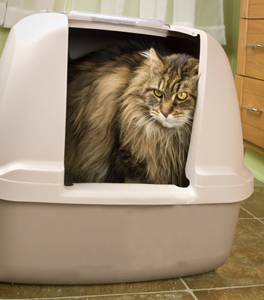Tips for Good Litter Box Placement

One of the reasons cats can develop inappropriate urination problems is because they do not like the location that you have chosen for the litter box.
Cats usually don't like the litter box to be in loud, high-traffic, non-private areas. Below are some tips for good litter box placement.
- Choose a peaceful area to place your cat's litter box where he won't be startled while he's using it. It should also be a place that provides privacy. If your cat feels unsafe in the area that you've provided, he will use a place that he finds more suitable, which may be in the back of your closet on some soft laundry. His pleasant experience in your closet may prove far more agreeable than his "scary" litter box, and then he may keep returning to the closet due to positive reinforcement.
- Place at least one litter box on each floor of your house. This is especially important for arthritic or geriatric cats, but no cat likes having to roam far to find a bathroom.
-
Place two boxes side by side. Many cats like to urinate in one box and defecate in another. Providing boxes close to each other but not touching, gives your cat options.

- Do not place the litter box on carpeting, a rug, or soft towels. The feel of the carpeting may be more attractive to your cat than the litter, encouraging him to branch out.
- Don't use soft materials at the opening of the litter box. While placing a mat at the litter box's entrance is a great idea to help control the spread of cat litter through your house, don't use a nice, soft bath towel. While your cat is walking over the towel to get into his litter box, he may decide that the towel feels more inviting and use it instead. From there, he may branch out to using towels, rugs, and blankets elsewhere in your home. Instead, choose a rubber or plastic mat with a criss-cross pattern that will help dislodge litter from your cat's feet when he steps out of the box. We love the Purr-fect Paws Cat Litter Mat.
- You should have as many boxes as you have cats, plus one. If you have three cats, you should have four litter boxes. Some cats do not like to use a box that another cat has used, while some like to cover the scent of another cat. Having plenty of boxes covers your bases.
- Don't move the box around. Find the best spot for the litter box, and if your cat accepts your decision, don't move it. If you absolutely must change the litter box location, do it gradually. Put a new box in the desired area, and then move the old box toward it by a few inches per day until your cat begins to use the new box.
- Choose a location with an escape route available. Cats always want to feel that they can get out of a situation if they need to. If your cat feels that his litter box is located at a dead-end, he might avoid using it.
- Consider a gate to keep children and dogs out of the litter box area. You can place the gate in a position that is perfect for your cat to slip under but positioned so that the dogs and children can't fit. Just be sure that the gate is nice and stable because a falling gate will be sure to traumatize an already-skittish kitty.
If your cat is urinating outside of the litter box, the first thing you should do is visit the veterinarian to rule out a medical cause.
Read more about inappropriate urination in cats here.
You May Also Like These Articles:
Cat Not Using Litter Box? Inappropriate Urination in Cats
Tips for Good Litter Box Cleaning
Why Does My Cat's Rear End Smell Bad?
How to Be Prepared for Your Cat's Veterinary Bills
Feline Lower Urinary Tract Disease
Earth Day: How to Green-Up Your Cat-Care Routine
Detecting and Cleaning Urine Stains
Notice: Ask-a-Vet is an affiliated service for those who wish to speak with a veterinary professional about their pet's specific condition. Initially, a bot will ask questions to determine the general nature of your concern. Then, you will be transferred to a human. There is a charge for the service if you choose to connect to a veterinarian. Ask-a-Vet is not manned by the staff or owners of CatHealth.com, and the advice given should not delay or replace a visit to your veterinarian.




